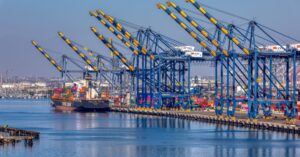At a busy airport, a main hub of inbound air freight for manufacturing, cargo planes touch down in rapid succession, their bellies full of critical components destined for assembly lines. Workers in orange vests orchestrate a ballet of forklifts and trolleys, swiftly unloading crates stamped with international symbols.
Customs officials ensure that all paperwork is in order and that what’s arriving can be cleared for receipt into U.S. commerce. Inspectors do spot physical checks. Logistics coordinators with freight forwarding companies closely monitor screens, ensuring each shipment has arrived intact and is quickly off to where it’s needed.
Amid all the bustle, COGISTICS Transportation is right in its wheelhouse, simplifying the complex and managing the logistical intricacies. A leading provider of transportation services both domestically and internationally, COGISTICS Transportation helps facilitate seamless air freight services for shippers of all kinds. It’s a complete end-to-end solution offering transparency, visibility, communication, and education throughout the air freight process.
Trends in Air Freight Demand
According to the International Air Transport Association (IATA), demand for air freight grew a healthy 18.4% in January, the second month in a row of double-digit growth coming off a mostly anemic 2023. The demand spike was the highest since the summer of 2021 when the pandemic caused it to skyrocket. However, capacity grew 14.6% in January, the IATA said, indicating a growing imbalance.
In an interview with Bloomberg News, Atlas Air CEO Michael Steen said air freight represents about 1% of global volume but 35% of global value. Steen said with demand coming back strong, he projected it will grow 4% per year in the near term, outstripping supply.
Air Freight Strategy for Inbound Manufacturing
While more expensive than ocean freight for inbound shipments, manufacturers use air freight strategically when time is of the essence. Weeks on the water just won’t cut it when parts or supplies are needed ASAP. Investing in air freight is a much better alternative than the huge expense and hassle of shutting down production or delaying customer orders.
Some typical hurdles manufacturers face in managing inbound air freight include tight deadlines and fluctuating costs and meeting regulatory requirements. Here are some other issues they face on a daily basis:
- Capacity constraints: Air freight capacity can be limited, particularly during peak seasons or due to supply chain disruptions. At times, it’s difficult to secure adequate capacity on available flights, causing delayed shipments.
- Damage and loss: This risk is higher with air freight due to the use of multiple handling points, the need for quick transfers between flights, and transloading between modes.
- Visibility and tracking: Maintaining visibility over the entire shipping process can be challenging. This requires accurate, real-time tracking systems to effectively manage the supply. Gaps in this data lead to inefficiency and increased costs.
- Customs and security clearances: Navigating the complexities of customs and security procedures can cause delays and require additional documentation, particularly for sensitive or hazardous materials.
- Environmental concerns: Air freight has a significant carbon footprint compared to other modes of transportation. Manufacturers are facing increasing pressure to reduce their environmental impact, which they have to factor into their transportation strategy.
- Geopolitical issues: Political instability and trade wars affect air freight logistics, including the introduction of new regulations, tariffs, or other barriers that complicate the shipping process.
All of these challenges have the potential to upset manufacturing schedules, throw a wrench into inventory management, and bump up operating costs. Still, air freight is a critical piece of the supply chain, even if it’s a small fraction of global cargo volume. It must be relied upon to keep production humming and inventory levels in a just-right zone.
Tactics for Streamlining Air Freight to Increase Efficiency
For manufacturers receiving inbound air freight, a number of processes must be optimized in order to ensure timely deliveries. It also involves close cooperation and communication with suppliers. Here are some main areas to consider:
- Coordinate shipments with suppliers well in advance, ensuring better integration with production schedules and less reliance on expedited shipping.
- Leasing a nearby warehouse allows companies to consolidate shipments and distribute them efficiently to their manufacturing facility.
- Working with an experienced freight forwarder like COGISTICS Transportation streamlines the customs clearance process, reducing delays and avoiding penalties.
Leveraging Technology
Advanced tracking and logistics management software provides visibility into shipment status, improving planning and response strategies. COGISTICS Transportation has proprietary software and tools that provide real-time supply chain visibility into inbound air freight.
Enterprise Resource Planning (ERP) systems integrate core business processes, providing manufacturers with visibility and control over inbound logistics, from order placement to receipt and use in production.
Transportation Management Systems (TMS) optimize planning, execution, and optimization of shipments. They can help with carrier selection, route planning, freight auditing, and payment, helping ensure materials are delivered on time and cost-effectively.
A Warehouse Management System (WMS) handles everything from inventory management to order fulfillment and labor management. Its job is to track and optimize the storage and retrieval of goods and ensure stock levels are in line with the production schedule.
Internet of Things (IoT) devices like GPS trackers and RFID tags provide real-time data on the location and condition of goods in transit. This information can be fed into an ERP for analysis, reporting, and forecasting, aiding in dynamic scheduling and risk management for inbound logistics.
A variety of software applications utilize artificial intelligence (AI) and machine learning (ML). They can analyze vast amounts of logistics data to predict and mitigate potential delays, optimize stock levels, and suggest refinements to logistics strategies.
Implementing a JIT Inventory Approach
Just-in-time (JIT) inventory management is a strategic approach aimed at closely aligning inbound shipments with production schedules. When done right, it can significantly reduce inventory on hand and related carrying costs, and optimize supply chains. A JIT approach streamlines operations so that parts and components are delivered right before they’re needed for production, eliminating the need for excess storage.
By adopting JIT, manufacturers can be more strategic in critical sourcing. They can keep only essential spare parts on hand and order others as needed, freeing up capital allocated to inventory. This method conserves space and resources while reducing waste and inventory obsolescence, resulting in a leaner, more cost-effective manufacturing operation.
In a JIT scenario, inbound logistics must be precise and reliable as there is less margin for error and a greater risk of stock shortfalls. Manufacturers need sophisticated tracking systems and tight supplier relations to ensure timely deliveries, often facilitated by ERP and IoT. This synchronization helps prevent production delays and maintains the continuous flow of manufacturing operations.
Ensuring Efficient Documentation and Customs Compliance
For inbound air freight shipments to manufacturing, several essential documents facilitate transport, customs clearance, and compliance. The overseas shipper is typically responsible for providing a commercial invoice, a packing list, an air waybill, a certificate of origin, and an export license.
The manufacturer as consignee has to provide a customs declaration, and an import license for certain products, both crucial for customs clearance. The consignee often handles insurance certificates and other compliance documents (inspection certificates, dangerous goods declarations). Effective coordination between shipper and consignee ensures that all documentation is accurate and submitted on time, avoiding delays and non-compliance penalties.
COGISTICS Transportation handles every aspect of documentation and clearance for inbound air freight. Data analytics enhance service delivery, visibility, communication, and compliance. All relevant information, including customs documentation, is captured as data points, translated into updates, and transmitted to parties dictated by the client. Documentation is also clearly displayed in a dashboard, so relevant parties can quickly determine shipment status and location.
All information is clearly displayed, so any internal questions or issues are quickly addressed. Satellite tracking, as well as downloadable PDFs of all documentation, are available and easily accessible while a shipment is in transit.
Improving Shipping Data Analytics: Can Standardization Happen?
Data management plays a key role as most required documentation is shared electronically. According to the IATA, data management is a key component of any air freight strategy, to address market fluctuations and shifting demand. Data analytics help shippers and consignees better understand market trends, provide leverage in carrier negotiations, and help optimize air freight logistics and spend.
Writing in FreightWaves, Bart De Muynck made the case for data standardization in logistics and freight management. Among the benefits are improved tracking of stock levels, the ability to more accurately forecast potential supply chain disruptions, and a streamlined data process. He acknowledged, however, that different systems, data formats, and regulatory requirements across trade partners and providers make it challenging and “a complex undertaking.”
Building Strong Logistics Partnerships
Collaborating with reliable logistics partners helps transportation and inventory managers deal with the complexity of inbound air freight for manufacturing. The right partner can help improve supply chain efficiency, working diligently to ensure that critical parts and supplies arrive on time to avoid production hiccups.
Shippers Need a Steady Hand to Assist in Volatile Times
With air freight demand growing and capacity creation not keeping pace, it might be a bit of a bumpy flight ahead for shippers. A host of issues confront manufacturers who rely on it to handle time-sensitive shipments. But with the right technology, strong vendor relationships and communication, and efficiency tactics like freight consolidation, manufacturers can use it to their strategic advantage.
COGISTICS Transportation, with its vast experience, technology platform, and efficient processes, simplifies your cross-border logistics. We turn the complexities of international air freight into a streamlined experience for shippers and consignees. Our global carrier network identifies the most efficient routes. From hassle-free customs clearance and regulatory compliance to a range of air freight modes (next day out, courier on board, air charter, economy, etc.), COGISTICS Transportation crafts a solution tailored to your unique needs. To learn more, contact us today.




